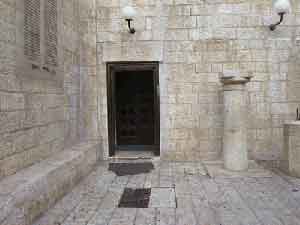Search our Archives:
» Home
» History
» Holidays
» Humor
» Places
» Thought
» Opinion & Society
» Writings
» Customs
» Misc.
|
The Ramban Synagogue; Hope Amidst Despair
Larry Domnitch
Seven hundred years before Israeli paratroopers made their way through gates surrounding the Old City of Jerusalem during the six day war. A great sage was building a cornerstone in Jerusalem. His contributions towards rejuvenating Jewish life in the holy city are everlasting. His impact upon history is monumental.
The Ramban, Nachmanides (1195-1270) lived during an era when the land of Israel suffered a wave of successive rulers who conquered and wreaked devastation. The conquerors greatest prize—Jerusalem was repeatedly sacked. In 1099, the crusades sacked Jerusalem and massacred both the Jewish and Muslim inhabitants, Saladin the Muslim conqueror wrested Jerusalem from the Crusaders in 1187. He allowed some Jews to reside in Jerusalem. Then, more conquerors arrived: the second crusades in 1229, the Tartars in 1244, and the Mongols in 1259, and a year later, the Mamelukes.
The Mongol invasion left Jerusalem a city of ruins. With their approach, some Jews fled; those who remained were massacred. The following year, the conquering Mamelukes permitted Jewish residency, but only a few returned.
In 1267, the Ramban made Aliyah from Spain. Aware of the dismal situation in the Land of Israel, he seemed to be planning Jerusalem's revival before he arrived. Just prior to his departure, he delivered a sermon during the holiday of Shmini Atzeret about the holiness of the land of Israel and the importance of giving charity. He was perhaps priming his congregants to support endeavors of building religious institutions within the land.
After a long and perilous journey, the Ramban arrived at the port city of Acco (Acre), at the age of seventy-two. After a brief stay, he left for Jerusalem and arrived of the ninth day of the month of Elul. He approached the city's gates and was struck by its desolation.
In a letter to his son, the Ramban wrote, "Many are its forsaken places, and great is the desecration. The more sacred the place, the greater the devastation it has suffered. Jerusalem is the most desolate place of all." Regarding the Jewish community, he added, "There are two brothers dyers by trade……There are ten men who meet on the Sabbaths they hold services at their home." But despite the devastation, the Ramban saw hope, "Even in its destruction, it is an exceedingly good land."
Efforts immediately began to rebuild the Jewish community. The Ramban chose one of many ruined houses—which possessed marble pillars and a beautiful arch—located on Mount Zion and began construction of a synagogue. Torah scrolls that were removed before the Mongol invasion and transported to the city of Shechem were returned. Word of the Ramban's presence brought more residents to Jerusalem. In just three weeks, the synagogue was ready for use, just as Rosh Hashanah had arrived. On that Rosh Hashanah, the Ramban delivered a sermon urging the new arrivals to remain in Jerusalem.
The next task was to set up a yeshiva. Word of the yeshiva expectantly drew students who journeyed to Jerusalem to be near the revered scholar, teacher, and leader.
Over time, the Jewish community of Jerusalem increased until it once again became the center of Jewish life in the land of Israel. Sephardim and Ashkenazim prayed and studied together in the synagogue for the next three hundred years until 1589. In that year, the city's governor, Abu Sufrin, turned it into a warehouse because of Muslim incitement. By then, however, the Jewish community was well established.
In the course of one year, the Ramban built a Jewish community that would continue and increase for the next seven hundred years until the Jordanian occupation of the Old City in 1948. A year after the Ramban re-established the community, he returned to Acco to lead the congregation there until his death two years later.
During the early stages of the War of Independence, forces of the Haganah valiantly fought a desperate battle to hold onto the Old City. Unable to hold on, they were forced to surrender. Following their surrender, the numerous synagogues of the Old City were soon destroyed and the remnants of hundreds of years of Jewish existence in Jerusalem were virtually wiped out. The Ramban synagogue which was relocated to the Old City about five hundred years ago was also destroyed. Independence was achieved, the dream of Jewish Statehood was realized, but Jerusalem's ancient streets again lay empty as during the dark days following the crusades. For nineteen years, until June 1967, Jews hoped and dreamed for the return of its Jewish community.

Today, the synagogues of the Old City have been restored. Along the landscape of the thriving Jewish Quarter stands the Ramban Synagogue-a cornerstone of Jerusalem. Its presence serves as a reminder of that early settlement-seven hundred year's earlier-diminutive as it was, but which preceded the many to follow. It also serves as testimony to the vision of the Ramban- from the ashes of Jerusalem, to the Jerusalem of today and to the Jerusalem of tomorrow.
~~~~~~~
from the April 1999 Edition of the Jewish Magazine
|
|
Please let us know if you see something unsavory on the Google Ads and we will have them removed. Email us with the offensive URL (www.something.com)
|





|
